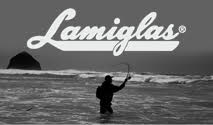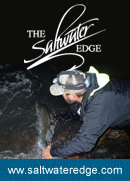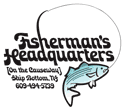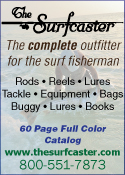Occasionally we feature guest bloggers on Surfcaster’s Journal Blog. Today we have a pleasure to present an article from Mr. Eric Brunley, noted author and fisherman whose books many of you have read…Zeno
A BRIEF HISTORY OF STRIPED BASS MANAGEMENT BY ERIC BURNLEY
The current system of striped bass management had its beginnings in the mid 1970s with the formation of the State-Federal Striped Bass Management Advisory Committee. Each state from Maine to North Carolina had three representatives on the committee. One from the commercial industry, one recreational fisherman and one representative from the state or commonwealth’s department of natural resources. I was the recreational representative from Delaware.
Our first meeting was in Salisbury, Maryland and it was a major education for me and I expect many of the others. The first thing I learned was everyone there knew exactly what was wrong with striped bass. The recreational members said the problem was the commercial men, the commercial men said it was the environment and everyone agreed the problem was caused by someone or something else. The trouble with that line of thought was we were all killing as many striped bass as we could and dead stripers do not make little stripers.
Another revelation was many of the recreational fishermen were in fact hook and line commercial fishermen. There were charter operators in New England who would take out parties, allow them to crank in the fish and then the captain would sell the catch back at the dock.
In Virginia wire line trollers would catch tons of stripers around the Chesapeake Bay Bridge Tunnel and sell them to seafood dealers and restaurants. When the stripers ran out, they switched their attention to weakfish.
With both factions having an economic interest in striped bass, it was hard to curtail the catch and in effect curtail someone’s income. In addition to the fisherman’s income there was the money spent on bait, tackle, boats, motors, fuel and all the other products and services supported by the striped bass fishing industry.
Some of our meetings were a little confrontational, but in the end we were able to agree on a few small measures to stop the decline of the species. The first regulation was a 12-inch minimum size for striped bass. Small as that seems now; it was a major milestone at the time.
Then we ran into the big problem; the Atlantic States Marine Fishery Commission had no authority to enforce any regulation. We would suggest a regulation, the commission would approve it and the states would ignore it. We also found the striped bass stock was collapsing faster than we could create regulations designed to stop the downfall.
Several members of the advisory committee decided that the only solution to the problem was a complete moratorium of catching and possessing striped bass. To this end we began a campaign to achieve that goal. We lobbied our various legislative bodies and even went to Washington DC to lobby congress. In spite of our work and dedication we accomplished nothing.
Two events occurred that finally solved the problem. The first was the passage of a federal law that allowed the ASMFC to stop all fishing in any state or commonwealth that failed to comply with one of their regulations.
The second was the announcement by the governor of Maryland that he was declaring a total moratorium on striped bass. Delaware followed almost immediately and then the ASMFC created a plan that included the moratorium and established the trigger that would restore striped bass fishing. The trigger would be pulled when the Chesapeake Bay Young of the Year Survey reached a certain level.
Soon after the moratorium began I discovered that trawlers were landing striped bass caught in the EEZ at Ocean City, Maryland and selling the fish to markets in the Midwest. This practice bypassed the ASMFC’s authority. At the time I was living in Maryland and contacted my state reprehensive. She was able to write and have passed a bill by the Maryland legislature prohibiting the landing of striped bass in Maryland and soon after the federal government placed the EEZ off limits to striped bass fishing.
Striped bass remained under a moratorium until 1989 when the new governor of Maryland, with strong support from the commercial fishing industry, was able to pull the trigger. In an action that I still believe was taken to insure the trigger was pulled, a new sampling site at Hambroke’s Bar was included in the Young of the year Survey. The count of YOY striped bass was so high at this new site that when combined with the poor numbers from all the traditional sites the average was high enough to reopen the fishery.
Fortunately, the ASMFC was able to create a very restrictive management plan that kept the mortality of striped bass down until we finally did have a real above average YOY.
The striped bass population has improved since the moratorium, but now we are seeing the same decline in the Chesapeake Bay’s YOY that we saw in the 1960s and 70s. With up to 90% of the coastwide population of striped bass coming from the bay we know this downturn will soon be felt all along the coast. We are seeing fewer small stripers in the Chesapeake and a downturn in the number of medium size stripers has been reported all along the coast.
My suggestion would be for everyone concerned with the current situation to pool their resources and put pressure on the politicians and the ASMFC to make some drastic changes. In my opinion, we need to start saving the large spawning females until they have a chance to reestablish the stock. Remember, as Pogo said, “We have met the enemy and he is us.”
Biography
Captain Eric B. Burnley Sr. has chased striped bass along the Atlantic Coast for more than forty years. For the past thirty-five years he has written about those experiences in any number of national and regional magazines, presented seminars on striper fishing and guided other anglers to successful encounters with striped bass. He is a full-time freelance writer living with his wife, Barbara, in their home state of Delaware. He is author of many books on fishing including Surf Fish the Atlantic Coast
[issuu layout=http%3A%2F%2Fskin.issuu.com%2Fv%2Flight%2Flayout.xml showflipbtn=true documentid=110308003917-21741ced73f243ec859cfedc908ef1cf docname=issue6 username=SURFCASTERS_JOURNAL loadinginfotext=issue%206 width=420 height=162 unit=px]












I wrote about the selling of bass all over the west and midwest on another site and a couple of commercial fishermen accused me of making it up-It is still going on today!
Captain Jason Colby
↓Little Sister Charters
617-755-3740
http://www.littlesister1.com
fishinglsister@aol.com
Eric we need you to help us do this correctly so we can pool our forces. If we don’t have someone w your firsthand knowledge of how & whom to talk to it will go by the wayside. I beseech you to please get together w zeno & lead us or organize our group so we can make a difference. The last 2 yrs fishing newport ri naragan bay, buzzards & the islands have been barren. Please guide us through this & help us out brother. Sincerely dr harv simon weston ct endosimon@aol.com 203 216 2523
↓I think the bass situation is dire now and requires an organized effort to control exploitation.
↓Thanks Eric, Zeno and SurfcastersJ for reminding us of the turbulent history inherent to these dynamic fish, and for being on the forefront of the management battle to keep this resource around for the next generations to enjoy.
↓Thanks to you and those like you who make it their lifes’ work to correspond, commemorate and conserve the heritage of fishermen.
Thanks Eric,Zeno & SJ. As sufcasters we need to do our part.. We need to practice more catch & release. I see too many fisherman who keep every keeper they catch..Last year I met a guy who told me he took home 25 bass during the 2010 season. How much striped bass can one person eat.I don’t care if you are saving them for yourself or giving them to friends ..Start thinking of the bass population.My opinion we should go back to a 36 inch limit..Thanks for all you guys do at SJ. You guys rock..
↓We had better get on the ball and bombard Ms.Berger after this notice. And let it be known that this estimate is low-ball.
FOR IMMEDIATE RELEASE, MARCH 24, 2011
PRESS CONTACT, TINA BERGER, 703/842-0740
ASMFC Atlantic Striped Bass Board Initiates Addendum to Reduce Fishing Mortality
Alexandria, VA – The Atlantic States Marine Fisheries Commission’s Atlantic Striped Bass Management Board has initiated development of Draft Addendum III with the goals of reducing striped bass fishing mortality (F) up to 40% and further protecting spawning stock when it is concentrated and vulnerable. The addendum was initiated in order to allow managers to promptly respond to the results of the stock assessment update in the fall if necessary. Provisions of the addendum, if passed, could be implemented prior to the start of the 2012 fishing year.
The Board’s action responds to recent trends in the fishery and resource, including a 66% decline in estimated recreational catch from 2006 to 2009; a 25% decline in estimated striped bass abundance from 2004 to 2008; and lowered recruitment in recent years. Additionally, states in the northern extent of the fishery have expressed concern over decreased availability of striped bass as a result of the diminished water quality in the Chesapeake Bay during the summer months that may also contribute to increased prevalence of mycobacteriosis in striped bass.
Draft Addendum III will propose a range of fishing management measures including, but not limited to, adjustments to commercial and recreational minimum size (for jurisdictions outside Chesapeake Bay and Albemarle Sound/Roanoke River), reductions in annual coastal commercial allocation, reductions in recreational bag limits, revisions to the target F rate (for Chesapeake Bay and Albemarle Sound/Roanoke River), and reductions on fishing for striped bass in known spawning areas during the spawning season by at least 50% (for jurisdictions bordering the Hudson River, Delaware River, Chesapeake Bay and Albemarle Sound/Roanoke River).
The commercial and recreational fishery is currently managed through Amendment 6 to the Striped Bass Fishery Management Plan. The Amendment, passed in 2003, allocates the coastal commercial quota and set a two fish bag limit and a 28 inch size minimum for the recreational fishery, with the exception of the Chesapeake Bay fisheries, Albemarle Sound/Roanoke River fisheries, and states with approved alternative regulations.
The Draft Addendum will be developed for preliminary review by the Atlantic Striped Bass Management Board in August. For more information, please contact Kate Taylor, Fishery Management Plan Coordinator, at ktaylor@asmfc.org or 703.842.0740.
↓